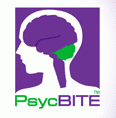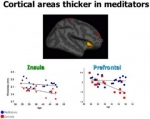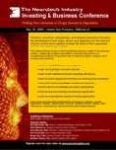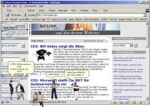Feb 22, 2006
Humans Ignore Motion and Stereo Cues in Favor of a Fictional Stable World
Humans Ignore Motion and Stereo Cues in Favor of a Fictional Stable World.
Curr Biol. 2006 Feb 21;16(4):428-432
Authors: Glennerster A, Tcheang L, Gilson SJ, Fitzgibbon AW, Parker AJ
As we move through the world, our eyes acquire a sequence of images. The information from this sequence is sufficient to determine the structure of a three-dimensional scene, up to a scale factor determined by the distance that the eyes have moved . Previous evidence shows that the human visual system accounts for the distance the observer has walked and the separation of the eyes when judging the scale, shape, and distance of objects. However, in an immersive virtual-reality environment, observers failed to notice when a scene expanded or contracted, despite having consistent information about scale from both distance walked and binocular vision. This failure led to large errors in judging the size of objects. The pattern of errors cannot be explained by assuming a visual reconstruction of the scene with an incorrect estimate of interocular separation or distance walked. Instead, it is consistent with a Bayesian model of cue integration in which the efficacy of motion and disparity cues is greater at near viewing distances. Our results imply that observers are more willing to adjust their estimate of interocular separation or distance walked than to accept that the scene has changed in size.
11:07 Posted in Virtual worlds | Permalink | Comments (0) | Tags: Positive Technology
Cognitive and Emotional Health Project
Via Brain Blog
The US National Institute on Aging (NIA), the National Institute of Mental Health (NIMH) and the National Institute of Neurological Disorders and Stroke (NINDS) have launched a new initiative, called Cognitive and Emotional Health Project. The goal of the initiative is to evaluate the state of the art in research on demographic, social and biologic determinants of cognitive and emotional health in aging adults.
From the website
10:55 Posted in Research institutions & funding opportunities | Permalink | Comments (0) | Tags: Positive Technology, funding opportunities
Feb 21, 2006
Assistive technology helps disabled kids find their voice
Via Science Daily
18:45 Posted in Brain training & cognitive enhancement | Permalink | Comments (0) | Tags: Positive Technology
PsycBITE
 PsycBITE is available online free of charge
PsycBITE is available online free of charge15:34 Posted in Research tools | Permalink | Comments (0) | Tags: Positive Technology
MSc in Human-Centred Systems, City University, London
The City University, London, offers a part-time, full-time, and flexible learning MSc in Human-Centred Systems, delivered by the world-renowned Centre for Human Computer Interaction Design.
Postgraduate internships in industry can also be undertaken as part of the degree.
Book online to attend the Open Evening:
then drop in any time between 5 and 7 pm to meet the Course Director and find out more.
14:58 Posted in Research institutions & funding opportunities | Permalink | Comments (0) | Tags: Positive Technology
Meditation may increase the thickness of the cortex
Science and Consciousness Review has interviewed brain researcher Sara Lazar on how meditation affects the brain. Lazar is the author of a recent study, in which magnetic resonance imaging was used to assess cortical thickness in 20 participants with extensive Insight meditation, a technique that involves focusing attention on internal experiences. Findings showed that brain regions associated with attention, interoception and sensory processing were thicker in meditation participants than matched controls, including the prefrontal cortex and right anterior insula. According to Lazar and her colleagues, these results provide preliminary evidence for experience-dependent cortical plasticity associated with meditation practice.

14:35 Posted in Meditation & brain | Permalink | Comments (0) | Tags: Positive Technology, meditation
Feb 20, 2006
Innovation between society and technoscience: Research perspectives and experience
Via STS Italia
First National Conference of STS Italia – Italian Society for Science and Technology Studies
9th-10th June 2006
Tiscali Auditorium, Cagliari (Sardinia)
Organizing Committee: Davide Bennato (Università di Roma “La Sapienza”), Alessandro Mongili (Università di Cagliari), Federico Neresini e Giuseppe Pellegrini (Università di Padova), Giuseppina Pellegrino (Università della Calabria).
Scientific Advisory Board: Davide Bennato (Università di Roma “La Sapienza”), Massimiamo Bucchi (Università di Trento), Luca Guzzetti (Università di Genova), Alessandro Mongili (Università di Cagliari), Federico Neresini (Università di Padova), Giuseppe Pellegrini (Università di Padova), Paolo Volontè (Università di Bolzano).
Sponsored by: Regione Autonoma della Sardegna – Assessorato per gli Affari generali, Dipartimento di Ricerche Economiche e Sociali dell’Università degli Studi di Cagliari, Banco di Sardegna, Tiscali SpA.
STS Italia is a research network which connects Italian scholars and academics interested in studying science and technology at both theoretical and empirical level.
The approaches and research perspectives pursued in the network consider relationships among science technology and society as a thick texture involving heterogenous actors, and reject any deterministic prejudice about the role of technoscience in society.
Research interests characterizing STS Italia concern theoretical and empirical analysis of science and technology in different contexts (from ‘laboratory studies’ to socio-technical networks; ftrom public perception of biotechnologies to domestication of technologies in everyday life).
STS Italia is inspired by the STS approach (Science and Technology Studies), which constitutes an inter- and trans-disciplinary field well known and institutionalized in Europe and the U.S.
The aim of STS Italia is to promote exchange, discussion and to strengthen the debate on science technology and society inside and outside Italian Universities.
The conference aims to attract a wide audience and broad participation, bringing together researchers engaged in investigating science and technology issues and willing to share their experience during plenary sessions and parallel workshops of the event. Younger researchers and Ph.D. students from University and other research centres are particularly welcome.
Provisional conference program
Plenary session 1
“STS: an international perspective. The state of the art in Science and Technology Studies”
Plenary session 2
“Technoscientific innovation and society: the Italian context”
Parallel workshops
“Research fieldwork and beyond: STS in Italy”
Suggested topics for abstracts:
- Theory, practices and normativity: the coordinates of the theoretical debate (social construction, actor-network, socio-technical networks and so on);
- Technosciences and democracy (governance, risk, public communication of science, ethics and development of technologies);
- “Ongoing processes” (biotechnologies, nanotechnologies, information infrastructures, internet/intranet, e-learning);
- Science, technology and gender;
- Communities of Practice, tacit knowledge and academic science;
- Practices of scientific knowledge, research policies and science crisis;
- Science, technology and social change.
The conference will be held at the Tiscali Campus Auditorium, “Sa Illetta”, SS 195 km 2,300, 09122 Cagliari, 2 kms. far from Cagliari city centre.
The abstract deadline is 9th April 2006
The acceptance of abstracts selected by the scientific advisory board will be communicated to authors by 10th May.
Participation to the conference is free (no registration fees). Partial coverage of travel and accommodation expenses for undergraduate, graduate and Ph.D. students will be provided. Requests for support will be selected by the Organizing Committee.
To send an abstract, download the form from www.stsitalia.org and send it via e-mail to alessandro.mongili@tiscali.it or by Snail mail to the following address:
Federico Neresini c/o Dipartimento di Sociologia – Università di Padova, Via Cesarotti 10/12, 35123 Padova
19:50 Posted in Positive Technology events | Permalink | Comments (0) | Tags: Positive Technology
Exploring spike transfer through the thalamus using hybrid artificial-biological neuronal networks
Exploring spike transfer through the thalamus using hybrid artificial-biological neuronal networks.
J Physiol Paris. 2004 Jul-Nov;98(4-6):540-58
Authors: Debay D, Wolfart J, Le Franc Y, Le Masson G, Bal T
We use dynamic clamp to construct "hybrid" thalamic circuits by connecting a biological neuron in situ to silicon- or software-generated "neurons" through artificial synapses. The purpose is to explore cellular sensory gating mechanisms that regulate the transfer efficiency of signals during different sleep-wake states. Hybrid technology is applied in vitro to different paradigms such as: (1) simulating interactions between biological thalamocortical neurons, artificial reticular thalamic inhibitory interneurons and a simulated sensory input, (2) grafting an artificial sensory input to a wholly biological thalamic network that generates spontaneous sleep-like oscillations, (3) injecting in thalamocortical neurons a background synaptic bombardment mimicking the activity of corticothalamic inputs. We show that the graded control of the strength of intrathalamic inhibition, combined with the membrane polarization and the fluctuating synaptic noise in thalamocortical neurons, is able to govern functional shifts between different input/output transmission states of the thalamic gate.
19:25 Posted in Biofeedback & neurofeedback | Permalink | Comments (0) | Tags: Positive Technology, Biofeedback, neurofeedback
SKeeper

Tadiran LifeCare, an Israeli company, has presented a compact wearable mobile communication and safety device (SKeeper™) for the elderly. The device
enables users to carry on with their daily routines without compromising safety and well being, by enabling them to stay in touch with relatives and caregivers in case of need. With SKeeper™ elderly people get immediate assistance by simply pressing a single button on the device, and parents can rest assured that their children can easily contact them should they be lost or need assistance
...
Using its embedded Siemens MC55 wireless module and built-in speakerphone, SKeeper™ can activate cellular voice calls to pre-defined numbers (e.g. a relative or a health professional) or receive calls from anyone. When a call is made to a monitoring center, a pre-defined SMS message can be sent automatically to a relative. Incoming calls can be screened and/or answered automatically. Most of the product features, such as speed dialing numbers, auto-answering, predefined text messages, etc. are remotely programmable by the monitoring center, or by the users or their authorized relatives via a Web based interface.
13:40 Posted in Brain training & cognitive enhancement | Permalink | Comments (0) | Tags: Positive Technology
Feb 19, 2006
Ambient Intelligence: algorithms, methods and applications
9, 10 and 11 October 2006, at the 10th International Conference on Knowledge-Based & Intelligent Information & Engineering Systems:
This special session will focus on Artificial Intelligence techniques, essential for implementing AmI systems, complementing past workshops, which are generally oriented towards computer vision for the AmI paradigm.
Areas of interest include, but are not limited to:
- multi-agent methods,
- multi-sensor fusion,
- intelligent human-environment interaction,
- advanced human-computer interaction,
- conventional and embedded robotics solutions,
- ambient representation and innovative sensors
Notification of acceptance: 1 April 2006 Final papers to be received by: 1 May 2006
22:55 Posted in Pervasive computing | Permalink | Comments (0) | Tags: Positive Technology, ambient intelligence
IST Mobile Summit 2006
IST Mobile Summit 2006 is taking place 4-8 June 2006, in Myconos, Greece
The Summit will distribute the latest information covering all aspects of wireless telecommunications for systems of present and future generation to managers, researchers, hardware/software designers and other professionals in the field. The conference will also cover policy, regulation and standardisation issues, which have a key role in the introduction of operative systems and services. The conference will include invited presentations from leading experts. Several demonstrations from European and International projects will also take place, as well as exhibitions.
Visit the event's web site for more information
14:30 Posted in Wearable & mobile | Permalink | Comments (0) | Tags: Positive Technology, wearable, mobile
Cybertherapy new investigator 2006 award announced
The aim of this prize is to reward the presentation of strong methodological studies at the Cybertherapy conference. The recipient has to be a researcher who is new to the field of cyberpsychology. It is open to both oral / symposium or poster presentations and to researchers from all countries and disciplines.
The award is delivered by Stéphane Bouchard, chairholder of the Canada Research Chair in Clinical Cyberpsychology. It includes a certificate and a check of 1 000 $ US.
Details of the award and its rules are described in the attached document and on the Conference web site
14:21 Posted in Research institutions & funding opportunities | Permalink | Comments (0) | Tags: Positive Technology
Feb 18, 2006
Effect of age and timing of augmented feedback on learning muscle relaxation
Effects of age and timing of augmented feedback on learning muscle relaxation while performing a gross motor task
Am J Phys Med Rehabil. 2006 Feb;85(2):148-55; quiz 156-8
Authors: van Dijk H, Hermens HJ
OBJECTIVE: To examine the combined effect of age and timing of augmented feedback on learning muscle relaxation. Performing a gross motor task, subjects had to lower their trapezius muscle activity using the electromyographic signal as visual myofeedback. DESIGN: Healthy subjects (16 young adults: 20-35 yrs; and 16 older adults: 55-70 yrs) were randomly assigned to one of two timing conditions of myofeedback: concurrent (feedback was provided immediately during the trial) and terminal (feedback was provided delayed after the trial) condition. RESULTS: The results indicated that young adults had a higher level of motor performance (i.e., lower muscle activity) compared with older adults when myofeedback was provided. These effects persisted during short- (after 10 mins) and long-term retention (after 1 wk) when no myofeedback was provided. In contrast to young adults, older adults did not improve their performance throughout the experiment. There were no interactions of age with the timing conditions of myofeedback during acquisition and retention. CONCLUSIONS: Either timing condition of augmented feedback was equally helpful to young adults, whereas neither was helpful for older adults in learning muscle relaxation.
13:15 Posted in Biofeedback & neurofeedback | Permalink | Comments (0) | Tags: Positive Technology, biofeedback, neurofeedback
Feb 16, 2006
Neurotech Industry Investing and Business Conference
Via Brain Waves
May 18, 2006, Millbrae, California
Westin San Francisco Airport
The Neurotech Industry Investing and Business Conference is a business and investment conference for the neurotechnology industry including pharmaceuticals, medical devices and diagnostics.
 Keynotes presentations will focus on state of the neurotech industry, cutting edge company presentations, and panel discussions on a comprehensive selection of neurotech topics.
Keynotes presentations will focus on state of the neurotech industry, cutting edge company presentations, and panel discussions on a comprehensive selection of neurotech topics.
10:36 Posted in Neurotechnology & neuroinformatics | Permalink | Comments (0) | Tags: Positive Technology
Feb 15, 2006
Capsules for relaxation

11:25 Posted in Meditation & brain | Permalink | Comments (0) | Tags: Positive Technology
Feb 14, 2006
Therapy in IVR-Cave 'holodeck'
Via the Presence-Listserv
(the following excerpt is from the original article published in the Observer)
Inspired by Star Trek's holodeck, a virtual reality theatre will be built for treatment and therapy purposes at the Cleveland Hearing and Speech Center. The theatre is titled, "Immersive Virtual Reality Cave Simulator" (IVR-Cave).
Under the guidance of Stacy Willams, an assistant professor in communication services at Case, the construction on the theater will be complete by April 2006. Williams formulated the concept of the room with inspiration from Star Trek while she was working on her master's degree."I was intrigued by the whole holodeck concept, and at the time [when working on a masters degree], I was learning the importance of carry-over techniques, or generalizing what you learn in therapy to a natural environment," Williams said.
With this new simulator, therapists will get a chance to show patients real-life scenarios in a controlled environment, before they are out on their own in the real world...
Read full article
14:49 Posted in Cybertherapy | Permalink | Comments (0) | Tags: Positive Technology
LLuna2
Via the LLuna2 website
LLuna2 is designed to enable virtual presence on Web sites with animated avatars, video, bubble chat, private chat, and personal profiles through the Jabber[tm] protocol, integrated with Jabber based Instant Messaging and operable without additional server components.

11:50 Posted in Telepresence & virtual presence | Permalink | Comments (0) | Tags: Positive Technology
Two postdoc positions available at CRAFT
Nicholas (Pasta and Vinegar) has announced that two postdoc positions are available at CRAFT (EPFL, the Swiss Federal Institute of Technology, Lausanne):
1) Three year position on the development of interactive furniture that augments learning in small groups. One of the projects will be about tables that reflect group interactions .
2) Three year position on the development of learning technologies aimed at students who rarely sit on a chair: apprentices working most of the week in a company and going one day at school. These technologies have to be more integrate in their physical environment (context aware devices, ambient displays, …)
Contact: pierre dot dillenbourg at epfl dot ch
11:35 Posted in Research institutions & funding opportunities | Permalink | Comments (0) | Tags: Positive Technology, funding opportunities
Forearm implanted chip to create an human-Ipod network
Researchers at the Korea Advanced Institute of Science and Technology (KAIST) presented a chip that is implanted in a user’s forearm to function as an audio signal transmission wire that links to an iPod. Many of the presentations featured devices that conserved power, though this chip goes a step further, harnessing the human body’s natural conductive properties to create personal-area networks. It is not practical to wire together the numerous devices that people carry with them, and Bluetooth connections fall prey to interference, leading scientists to explore the application of the human body as a networking cable. The Korean scientists augmented an iPod nano with their wideband signaling chip. When a user kept his finger pressed to the device, it transmitted data at 2 Mbps, at a consumption rate lower than 10 microwatts. Researchers from the University of Utah also presented a chip that scans brainwave activity by wirelessly streaming data through monitors in the hopes of creating prosthetics that quadriplegics could operate with their brain waves, though both projects are still in the preliminary research stages.
(…)
These chips are not something that will be included in one of Apple Computer CEO Steve Jobs’ Macworld keynotes anytime soon.
11:34 Posted in Future interfaces | Permalink | Comments (0) | Tags: Positive Technology
Perfectly normal

PerfectlyNormal is an interactive web-based video project that offers fourteen short video-based therapies. Depending on the "patients'" auto-description of their mental state, the web site automatically delivers one therapeutic video. According to the website disclaimer, the video-therapies were developed following principles of actual healing techniques derived from several different practices.
PerfectlyNormal is a web-based project commissioned by Soil Digital Media Suite, Neutral Ground Gallery, Regina, Saskatchewan, Canada. The project's author is composer and new media artist Michael Stecky (read short bio).From the project's website:
Bringing a unique healing experience, PerfectlyNormal, provides you and your family with the best integrated mental health care model the internet has to offer. Receive a personalized video therapy from our collection, a virtual one-stop shop of the best conventional and alternative practices from a diverse and interesting range of modalities.
PerfectlyNormal is an easy to use healing site made to work with you in mind. Visit when you like, PerfectlyNormal is available to you 24 hours a day, everyday. Now, feeling normal is only a mouse click away. PerfectlyNormal, have a perfect day everyday. PerfectlyNormal comes to you courtesy of the PerfectlyNormal Therapeutic Cooperative Alliance (PNTCA), a prestigious international group of like-minded therapists who share an inclusive spiritual philosophy.
11:25 Posted in Cyberart | Permalink | Comments (0) | Tags: Positive Technology, cyberart






